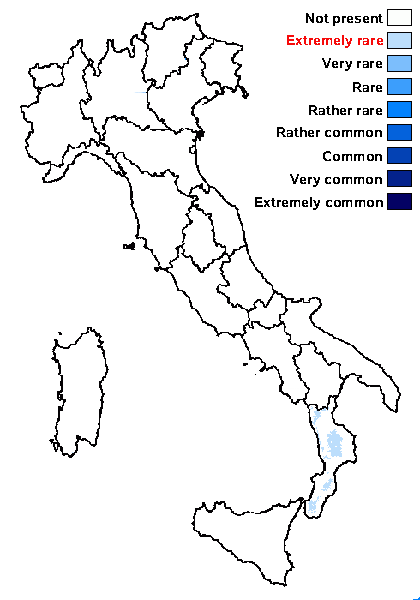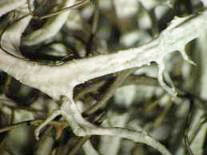Evernia illyrica (Zahlbr.) Du Rietz
Svensk Bot. Tidskr., 20: 90, 1926. Basionym: Evernia divaricata subsp. illyrica Zahlbr. - Ann. K.K. naturhist. Hofmus. Wien, 19: 418, 1904.
Synonyms: Letharia illyrica (Zahlbr.) Harm.
Distribution: S - Cal (Puntillo & Vezda 1994, Puntillo 1995, 1996).
Description: Thallus fruticose, attached with a basal holdfast, pendulous, up to 30 cm long, not dorsiventral, grey to whitish grey on all sides, richly but irregularly branched, with mostly obtuse axils, the main branches mostly parallel, sometimes entangled, subterete to angular, soft, 0.5-1,5(-3.5) mm wide, smooth or with shallow longitudinal grooves, with scattered side branches, the tips sometimes darkened, subulate or abruptly acuminate. Cortex matt, often degenerating in places and frequently cracking transversely in old specimens, exposing the white medulla which is loose, more or less arachnoid but often coherent as a soft central strand. Apothecia very rare, lecanorine, sessile, lateral on the main branches, up to 4 mm across, with a brown, flat disc and a thin thalline margin. Asci 8-spored, clavate, Lecanora-type. Ascospores 1-celled, hyaline, ellipsoid, c. 7 x 4 µm , often poorly developed. Pycnidia terminal on short side branches. Photobiont chlorococcoid. Spot tests: cortex K+ bright yellow, C-, KC-, P-. Chemistry: cortex with atranorin, medulla with divaricatic acid.Note: a Mediterranean-montane species found in humid beech-fir forests. An earlier record from Venezia Giulia cited by Nimis (1993: 294) is excluded, being from Slovenian territory (Tarnova, near Gorizia). It is included in the Italian red list of epiphytic lichens as “Endangered” (Nascimbene & al. 2013c).
Growth form: Fruticose
Substrata: bark
Photobiont: green algae other than Trentepohlia
Reproductive strategy: mainly asexual, by thallus fragmentation
Most common in areas with a humid-warm climate (e.g. most of Tyrrenian Italy)
Commonnes-rarity: (info)
Alpine belt: absent
Subalpine belt: absent
Oromediterranean belt: absent
Montane belt: extremely rare
Submediterranean belt: absent
Padanian area: absent
Humid submediterranean belt: absent
Humid mediterranean belt: absent
Dry mediterranean belt: absent

Predictive model
Herbarium samples
Growth form: Fruticose
Substrata: bark
Photobiont: green algae other than Trentepohlia
Reproductive strategy: mainly asexual, by thallus fragmentation
Most common in areas with a humid-warm climate (e.g. most of Tyrrenian Italy)
Commonnes-rarity: (info)
Alpine belt: absent
Subalpine belt: absent
Oromediterranean belt: absent
Montane belt: extremely rare
Submediterranean belt: absent
Padanian area: absent
Humid submediterranean belt: absent
Humid mediterranean belt: absent
Dry mediterranean belt: absent

Predictive model
| Herbarium samples |
 Index Fungorum
Index Fungorum
 GBIF
GBIF


